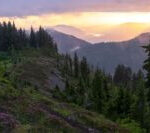Acadia National Park, a jewel on the coast of Maine, offers a unique experience for cyclists: its historic carriage roads. These well-maintained, crushed rock roads, totaling 45 miles, wind through the park’s stunning landscapes, providing breathtaking vistas away from the hustle of motor vehicle traffic. Perfect for leisurely rides and scenic exploration, the carriage roads are a legacy of thoughtful design and a haven for bike enthusiasts.
Cycling Etiquette and Safety on Carriage Roads
Sharing the carriage roads respectfully ensures a pleasant experience for everyone. Cyclists should be aware that these paths are also used by pedestrians and equestrians. The key rule is yielding: cyclists must yield to everyone, and pedestrians and cyclists alike must yield to horses. To maintain safety and the tranquil atmosphere, a speed limit of 20 mph is enforced for bicycles. It’s also important to note that only Class 1 e-bikes are permitted on these roads, while Class 2 and 3 e-bikes are not allowed, preserving the roads’ integrity and pedestrian safety. Remember, bicycling is restricted to carriage roads only; hiking trails and private carriage roads are off-limits to bikes. Seasonal closures are also something to keep in mind. During winter, when the roads are groomed for skiing, bikes are not permitted. Additionally, spring mud season, typically in March and April, often leads to temporary closures to protect the road surfaces. Always heed posted signs and check for alerts to stay informed about any temporary closures before you head out.
The Visionary History Behind the Bike Carriage Roads
The creation of Acadia’s carriage roads is a fascinating story of philanthropy and a passion for preserving natural beauty. John D. Rockefeller Jr. and his family gifted these roads to the park, overseeing their design and construction from 1913 to 1940. Inspired by his father, John D. Rockefeller Sr.’s road-building endeavors, the junior Rockefeller aimed to create a state-of-the-art system that separated different types of traffic, ensuring a peaceful experience amidst nature. Local talented masons and Italian immigrants, skilled in their craft, were instrumental in building these roads. Rockefeller’s personal involvement was remarkable; he meticulously reviewed road alignments, observed the construction progress, and even knew the laborers by name. His attention to detail was paramount, ensuring every aspect, from bridge design to the placement of stones, was perfect.
Distinctive Features of the Carriage Roads
Several elements contribute to the unique character and harmonious integration of the carriage road system with the Acadia landscape:
Coping Stones: “Rockefeller’s Teeth”
Large, roughly cut granite blocks line the carriage roads, acting as rustic guardrails. Irregularly spaced, these “coping stones” are affectionately known as “Rockefeller’s teeth,” adding a distinctive visual element to the roadsides and guiding cyclists along the paths.
Signposts: Historic Wayfinders
Cedar signposts, stained in a specific shade, were originally installed to guide carriage drivers. Today, these historic posts, marked with numbers corresponding to maps and guidebooks, continue to serve as wayfinders for cyclists and other carriage road users, helping navigate intersections and distances.
Roadside Grooming and Landscaping: Enhancing the Views
Rockefeller employed foresters to maintain the roadsides, ensuring they were free of debris. Renowned landscape architect Beatrix Farrand consulted on planting designs, strategically framing vistas, highlighting bridges, and softening the visual impact of construction. Although the Fire of 1947 unfortunately destroyed much of her original work, the principles of thoughtful landscaping remain evident.
Gate Lodges: Welcoming Entrances
Two gate lodges, located at Jordan Pond and near Northeast Harbor, serve as ornamental entrances to the carriage road system. These impressive structures add architectural interest and a sense of grandeur to the landscape. A third gate lodge was planned but never built, adding a touch of historical what-if to the carriage road narrative.
Bridges: Stone-Faced Masterpieces
Seventeen unique, stone-faced bridges, financed largely by Rockefeller, are integral to the carriage road system. Each bridge is a distinct design, constructed from steel-reinforced concrete but faced with native stone to blend naturally with the environment. The skilled stone cutters even had to be careful not to make the stonework too perfect, ensuring the desired rustic aesthetic was maintained.
Conclusion: Experience the Carriage Roads by Bike
Cycling the carriage roads of Acadia National Park is more than just a bike ride; it’s an immersion into history, thoughtful design, and breathtaking natural beauty. Whether you bring your own bike or rent locally, exploring these roads offers a unique perspective of the park, inviting you to enjoy miles of peaceful riding amidst stunning scenery. Plan your visit, grab a carriage road map, and prepare to discover the legacy of Rockefeller’s vision on two wheels.

